
Medically reviewed by Sian Baker, Dip ION mBANT mCNHC
on April 01, 2023. To give you technically accurate, evidence-based information, content published on the Check My Body Health blog is reviewed by credentialed professionals with expertise in medical and bioscience fields.
Signs & Symptoms of a Rice Intolerance or Allergy
A rice intolerance or allergy is when you experience symptoms after eating rice or food containing rice. Symptoms can be unpleasant, ranging from itchy skin to stomach pain. Serious allergies can cause breathing difficulties or anaphylaxis, but thankfully this is rare.
In this post, we’re going to explore the signs and symptoms of rice allergies and intolerances, how common they are and what food to avoid if you suspect you suffer from one.
What are the symptoms of a rice allergy?
As rice is a member of the grass family, many symptoms of a rice allergy are similar to the effects of hay fever, including coughing, sneezing, wheezing and shortness of breath. However, depending on the severity of your allergy, there can be a range of symptoms:
- Nausea, sickness or diarrhoea
- Hives, a rash or itchy skin
- Abdominal pain and cramps
- Breathing difficulties or tightening of the throat
- Pale or discoloured skin
- Lightheadedness or dizziness
In some cases you may also experience anaphylaxis, however this is rare. If you experience any or a combination of these symptoms after eating rice you may have a rice allergy. You don’t need to eat rice to experience symptoms of an allergy, for example, if you’re close to a rice field or you’re in a room where someone is cooking rice.
What are the symptoms of a rice intolerance?
The symptoms of a rice sensitivity will vary, but you’ll only experience them after you’ve eaten food containing rice. Common rice intolerance symptoms include:
- Stomach or intestinal pain
- Bloating
- Constipation
- Diarrhoea
- Fatigue
What is food intolerance?
A food intolerance develops when your body struggles to digest a particular food. Unlike an allergic reaction, an intolerance and the symptoms you experience aren’t caused by your body’s immune system – they actually come from the difficulty your body has because it can’t metabolise or process certain food compounds. Thankfully, intolerances are usually less severe than an allergic reaction, however, they can still cause a great deal of discomfort, pain, anxiety and stress.
How common is a rice intolerance?
In East Asian countries, rice intolerances can be relatively common because rice plays such a major role in many people’s diets. But, in the UK, Europe and the US, rice intolerances are far less common – but, a sudden food intolerance can happen at any point in your life.
How do you test for a rice allergy or intolerance?
If you suspect you have a rice allergy or sensitivity, there are several things you can do to find out:
- Consult your doctor, who can advise you on the relevant steps after considering your medical history, diet and lifestyle.
- Create a food diary to keep a record of the food you eat and whether or not you experience any allergy or intolerance symptoms after eating rice.
- Attempt an elimination diet by removing rice and rice products from your diet for several weeks to see if the symptoms reoccur.
- Take a food sensitivity test, which is the fastest and most accurate way to discover whether you have an allergy or intolerance to rice as well as hundreds of other foods.
What should you do if you think you have a rice allergy or intolerance?
If you believe you have a rice intolerance or allergy and frequently experience symptoms after eating dishes that contain rice, you should try to eliminate it from your diet until you can get a reliable diagnosis. This is especially true if you suspect you have an allergy, as the symptoms may worsen over time.
It’s important not to self-diagnose whether you have an allergy or intolerance, as many of the symptoms are similar. Speak to a health professional or take a complete sensitivity health test for reliable and accurate confirmation.
What foods should you avoid if you have a rice allergy or intolerance?
If you suspect you have a rice allergy or intolerance, or you’ve recently had a confirmation that you do, you should pay close attention to what you eat so you avoid accidentally eating something that contains rice. While rice isn’t as widely used as wheat or eggs, there are certain foods you should avoid:
- Rice flour
- Rice noodles
- Rice cakes
- Rice milk
- Rice pudding
- Certain cereals
- Certain granola bars
- Certain chocolates and sweets
- Sushi
- Sake
- Risotto
- Biryani
- Paella
10 alternatives to rice
- Riced cauliflower
- Riced broccoli
- Riced potato and sweet potato
- Couscous
- Quinoa
- Barley
- Orzo
- Farro
- Bulgur wheat
- Chopped cabbage
How to test if you have a rice allergy or intolerance
The symptoms of a rice intolerance or allergy are always unpleasant. Plus, the effects can get worse over time, so it’s best to find out for sure which foods you need to avoid.
Order a complete sensitivity health test or an essentials sensitivity test to discover more about your body’s intolerances and take control of your health in just five working days.




